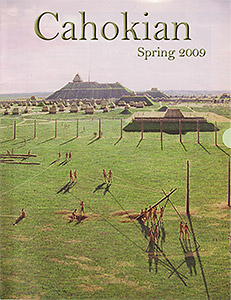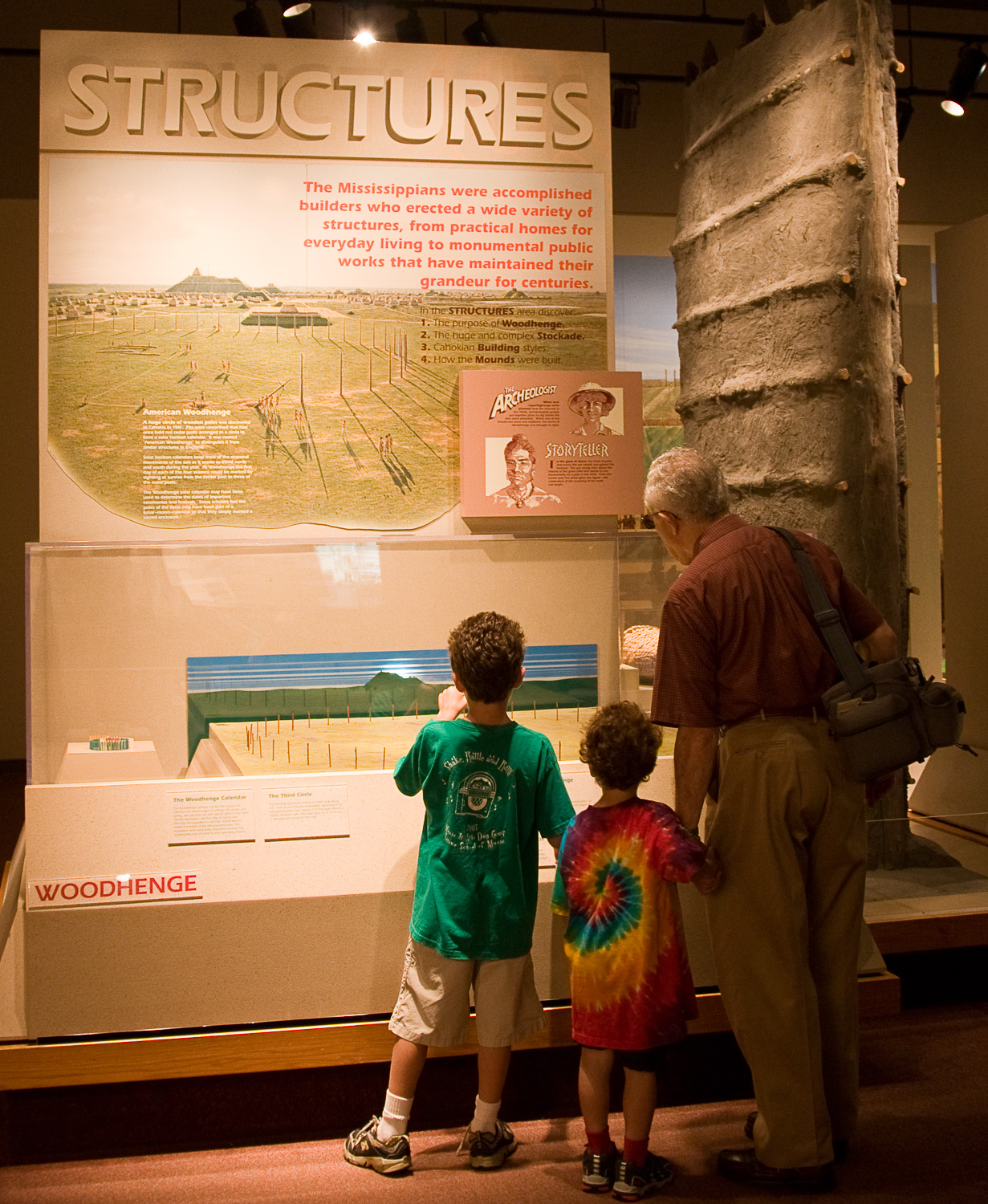Archeoastronomy
Michael had a long-time interest in archaeoastronomy, which is the study of how ancient civilizations used astronomy (often called "the oldest science") to understand the world around them and bring meaning to their lives. Numerous examples exist of structures or buildings which have special alignments for solar (solstice, equinox) or lunar calendar events.
Perhaps the most famous of these is Stonehenge, in southern England. Shown at left is a photo of Michael's children (Rachel and David) standing next to Stonehenge in 1971 (in the days when one could still really stand next to and touch the stones), when we made a special trip from London, where Michael was on sabattical at Imperial College.
As it turns out, one of the most important of these in North America is the Woodhenge [Also Wikipedia] at Cahokia Mounds (a UNESCO World Heritage Site) in Southern Illinois, about a 30 minute drive from Michael's home.

Warren Wittry
on observer's pole
at Cahokia, 1977
From PInterest post (linked)
Photographer unknown

Warren Wittry shown aligned with
Monks Mound from woodhenge site
Fall Equinox, September 1977.
Photo © by Michael Friedlander, Sept 1977
In the early 1960s, Dr. Warren Wittry,research associate in anthropology at the University of Illinois-Chicago Circle, performed excavations at the Cahokia Mounds site, paid for by the Illinois Department of Transportation, as the area was slated to be cleared for an interstate highway. He discovered evidence of the solar-aligned woodhenge (ring of posts) that lined up with one end of Monks Mound at the equinoxes.
The area remained undeveloped for years thereafter. I (David) can remember joining my dad for pre-dawn trips across the Mississippi River to Cahokia Mounds in order to see the sun rise at the equinox or solstice from the Woodhenge site. In those days (mid-1970s), it was nothing but a field, with thigh-high grasses, about 2/3 of a mile west of the 100 foot tall Monks Mound. Later, a pair of posts were erected, as shown in this Illinois State Museum photo of Warren Wittry. It was not until 1985 that the full circle was re-built and dedicated.
These days the Woodhenge is a central part of the identity of Cahokia Mounds and its Museum. One can see this from the Cahokian newsletter, which has featured the Woodhenge on its cover since shortly after the 1977 equinox illustrated at right. (David assembled this 8-page PDF below from Michael's Cahokian subscription.)
In 2007, Michael published an article in The Wisconsin Archaeologist (shown below) in which he performed calculations on the positions of the posts. (This was the first time a physicist had addressed the Woodhenge issues, as opposed to archaeologists.]

selection of Cahokian covers 1978-2009
showing woodhenge on the cover
Michael's interest in these was far more than a modern "Gee whiz!" reaction, but one of an astronomer who wished to truly understand what these works represented. He wrote articles and gave lectures (colloqia and for general audiences) about archaeoastronomy.
There were some interesting facets to these. I (David) can remember his describing the positions at Stonehenge, for which some of the markings were for events in 54 year cycles, remarkable because (a) this was longer than the average lifespan at the time and (b) this for a society with no written records. [Writing this from teen-age memory; apologies for any inaccuracies in this. Errors are mine not his.]
As one can see from the Public Talks and Lectures page elsewhere on this site, he was giving talks on archaeastronomy at least as early as 1978 and as late as 2013 (two years before health matters curtailed his availability for public talks). His interest in archaeastronomy also led him to join the Wash U Center for Archaeometry in 1976, described here.
In addition, in 1985 he published a freshman astronomy text titled "Astronomy: From Stonehenge to Quasars." (See link below.) Most colleges require a science course as a "distribution requirement," "core," or "general education" curriculum, and astronomy is one of the most popular such offerings. The unusual aspect of this textbook was indeed its emphasis on archaeoastronomy, which was woven in throughout the book.

Astronomy of the Ancients
Washington University Magazine, Spring 1980

Michael explains the Cahokia woodhenge to grandsons Noah and Rafael (August 2007).
Noah is holding down the "equinox" button/light.
Cahokia Mounds State Historic Site museum

Michael (left) stands with Colin Renfrew (far right) at the base of Monks Mound,
Cahokia Mounds Historic Site, March 2007.
Colin Renfrew
is a professor of Archaeology at Cambridge.
Shown with Michael,
Mark Esarey (Illinois Historic Preservation Agency's chief archaeologist),
Cricket Kelly,
John Kelly (senior lecturer in Archaeology, Washington University),
Lord Renfrew was in town to
deliver an endowed lecture at Wash U that March.
Photographer unknown.



